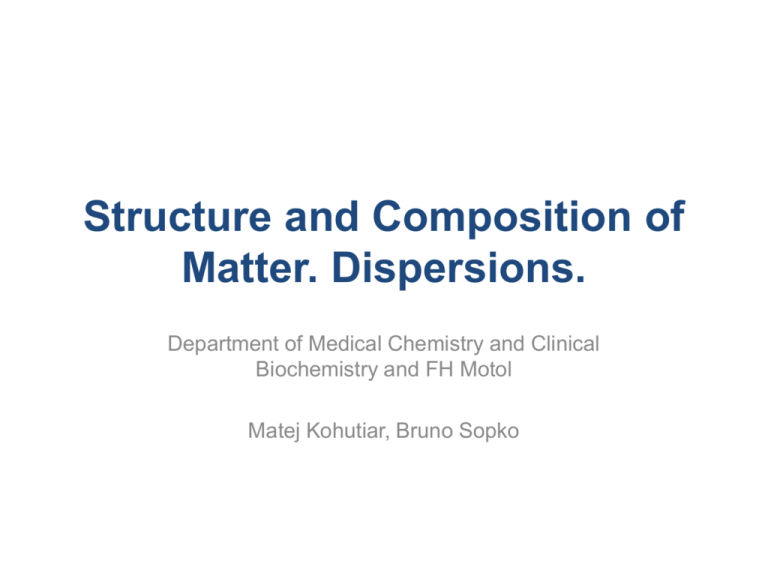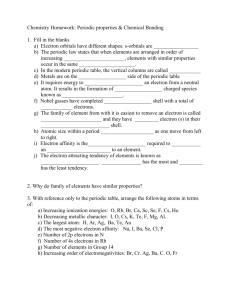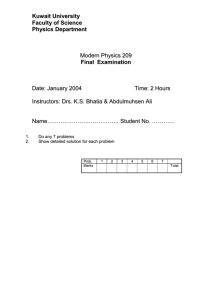Structure and Composition of Matter. Dispersions.
advertisement

Structure and Composition of Matter. Dispersions. Department of Medical Chemistry and Clinical Biochemistry and FH Motol Matej Kohutiar, Bruno Sopko Content 1. 2. 3. 4. 5. 6. Atom Chemical bond Gas phase Liquid phase Solid state Dispersions and colloid systems Atom • Atom: nucleus + electron cloud • Nucleus: nucleons = protons + neutrons • Electron cloud: electrons Atomic number Nucleon number Neutron number Atom • Atom: nucleus + electron cloud • Nucleus: nucleons = protons + neutrons • Electron cloud: electrons Atomic number Nucleon number Neutron number 16 O 8 Particles Electron • Dualistic properties – wave and particular • Wave function and orbital Electron and Wave Function Electron and Wave Function Electron and Wave Function Electron and Wave Function Electron and Wave Function Electron and Wave Function Electron and Wave Function Electron and Wave Function Electron and Wave Function Electron and Wave Function Electron and Wave Function Electron and Wave Function Electron and Wave Function Electron and Wave Function Atomic orbitals Quantum number 2. Chemical Bond Electronegativity • The ability of an atom in a molecule to attract shared electrons to itself • • • • Pauling Mulliken X=(1/2,8). (I+A)/2 Trend in PSP electropositivity Electronegativity in PSP Chemical bonds • • • • • Ionic bond Covalent bond (polar x nonpolar) Coordinate bon Metal bond Week Intermolecular interactions Ionic bond • There is no 100% ionic bond • Electronegativity difference (Δ≥1.7) • Move of electrons toward elemnt with higher electronegativity • High tv, tt Covalent bond • „electron sharing “ 0,4≤ Δx <1,2 • Polar x nonpolar • „Attracting“ force of one atom influences the other → vibrant equilibrium Coordinate covalent bonding • Electron pair donor/acceptor • Coordination compounds • Central atom (metal ion) and Ligand • Central atom : vacant orbital • Ligand: electron pair donor Coordinate covalent bonding Intermolecular Forces • 10 x weaker than covalent bonding • Chlorine sublimation 25,2 kJ/mol • Chlorine dissociation 243 kJ/mol • Interaction: ion-ion • Interaction: dipole-dipole • Interaction: ion-induced dipole London’s Forces • Between nonpolar molecules • Permanent electron oscillation • Interaction: induced dipole-induced dipole Hydrogen Bond • Very electronegative atom: F, O, N • 10-40kJ/mol • Boiling point.. Bond Polarity • Bond polarity • Molecule polarity 3. Gas phase Gas • ρ, p, T, V, n • Ideal mixing (1 phase) pV nRT Amagat’s law V1 + V2 = V1+V2 Dalton’s law Gas V Vi i p pi i RT p pi V i n i i Gas exchange - circulation Henry's law Vi i pi Henry's law Vi i pi T 310 K p 101325 Pa pO2 14,18kPa pCO2 6,13kPa Henry's law Vi i pi T 310 K p 101325 Pa O 1,97 104 cm3kPa1 / 1cm3 pO2 14,18kPa CO 4,93 103 cm3kPa1 / 1cm3 pCO2 6,13kPa 2 2 Henry's law Vi i pi T 310 K p 101325 Pa O 1,97 104 cm3kPa1 / 1cm3 pO2 14,18kPa CO 4,93 103 cm3kPa1 / 1cm3 pCO2 6,13kPa 2 2 VO2 1,97 10 4 14,18 2,79 10 4 cm 3 / 1cm 3 0,28cm 3 / 100cm 3 plazmy Henry's law Vi i pi T 310 K p 101325 Pa O 1,97 104 cm3kPa1 / 1cm3 pO2 14,18kPa CO 4,93 103 cm3kPa1 / 1cm3 pCO2 6,13kPa 2 2 VO2 1,97 10 4 14,18 2,79 10 4 cm 3 / 1cm 3 0,28cm 3 / 100cm 3 plazmy 3 VCO2 4,93 10 6,13 0,030cm / 1cm 3cm 3 / 100cm 3 plazmy 3 3 Maximal depth of dive? 98% He + 2% O2 pO2 101,325 0,20 20265 Pa pmix 20265 1013250 Pa 1013kPa 0,02 pcelk patm hg 101 h 1000 9,81 1013 h 93m 4. Liquid phase Liquid phase Liquid phase 1716,99 log p 4,14259 234,268 t h 3000m; t 17 C p 71,12kPa t 90,3 C 5. Solid state Solid state Solid state 6. Disperse and Colloidal Systems Dispersions • Disperse phase • Disperse environment • • • • Sorting: According the size of dispersed particles According the shape of dispersed particles According the amount of dispersed particles Dispersions Colloid Systems Colloid Systems Lyosol 1. Lyophobic system 2. Lyophylic system 3. Associative colloidal systems (Gel) Lyophobic colloidal system Lyophilic colloidal systems Associative colloidal system Micelles Lipoprotein structure Phase diagram - Bile Sources • • • • • • • • • • • • • • • • • • • • • • • • • • • • • • • • • • • https://www.lifecellaustralia.com/blog/posts/skin-structure • http://commons.wikimedia.org/wiki/File:1K6F_Crystal_Structure_Of_The_Collagen_Triple_Helix_Model_Pro-_Pro-Gly103_05.png • http://www.sfdm.scad.edu/faculty/mkesson/vsfx319/wip/best_winter2007/jesse_weglein/maya_pattern_animation/maya_pattern_animation.html • http://chemed.chem.purdue.edu/genchem/topicreview/bp/1biochem/blood3.html • http://en.wikipedia.org/wiki/Hepatocyte • http://www.primesight.net/education.htm • http://www.quantumintro.com/ • http://www.universetoday.com/56747/atom-structure/ • http://chemwiki.ucdavis.edu/Physical_Chemistry/Quantum_Mechanics/Atomic_Theory/Electrons_in_Atoms/Electronic_Orbitals • http://www.chem.ufl.edu/~itl/2045_s99/lectures/lec_12.html • http://www.science.uwaterloo.ca/~cchieh/cact/c120/bondel.html • https://www.e-education.psu.edu/earth520/content/l5_p3.html • http://virtuallaboratory.colorado.edu/Biofundamentals/lectureNotes-Revision/Topic2B_Water.htm • http://www.grandinetti.org/Teaching/Chem121/Lectures/MOTheory • http://en.wikipedia.org/wiki/Deferasirox • http://wps.prenhall.com/wps/media/objects/3313/3393071/blb2402.html • http://www.aboutthemcat.com/chemistry/chemical-reactions.php • http://www.wiley.com/college/boyer/0470003790/reviews/pH/ph_water.htm • http://blogs.harrisonhigh.org/jamey_stiltz/chemistry/unit-4-bonding/ • http://science.uvu.edu/ochem/index.php/alphabetical/g-h/hybridization/ • http://www.nature.com/nature/journal/v398/n6724/fig_tab/398223a0_F3.html • http://en.wikipedia.org/wiki/File:Gold_nanoparticle_Zeta-potential.png • http://www.mi2g.com/cgi/mi2g/frameset.php?pageid=http%3A//www.mi2g.com/cgi/mi2g/press/110210.php • http://www.bbc.co.uk/news/science-environment-15093234 • https://www2.chemistry.msu.edu/faculty/reusch/virttxtjml/lipids.htm • http://www.rsc.org/learn-chemistry/resources/chemistry-in-your-cupboard/finish/6 • http://www.ach.nitech.ac.jp/~physchem/taga/1tagag_e.html • http://eweb.furman.edu/~wworthen/bio111/cellover.htm • http://www.uic.edu/classes/bios/bios100/lecturesf04am/lect02.htm • http://eatingacademy.com/nutrition/the-straight-dope-on-cholesterol-part-ii • http://www.uptomed.ir/Digimed.ir/sabiston-2009/Sabiston_2009/HTML/518.htm • http://en.wikipedia.org/wiki/File:Gibbs-donnan-en.svg http://www.rci.rutgers.edu/~uzwiak/AnatPhys/Respiratory_System.html http://butane.chem.uiuc.edu/pshapley/GenChem1/L13/1.html






